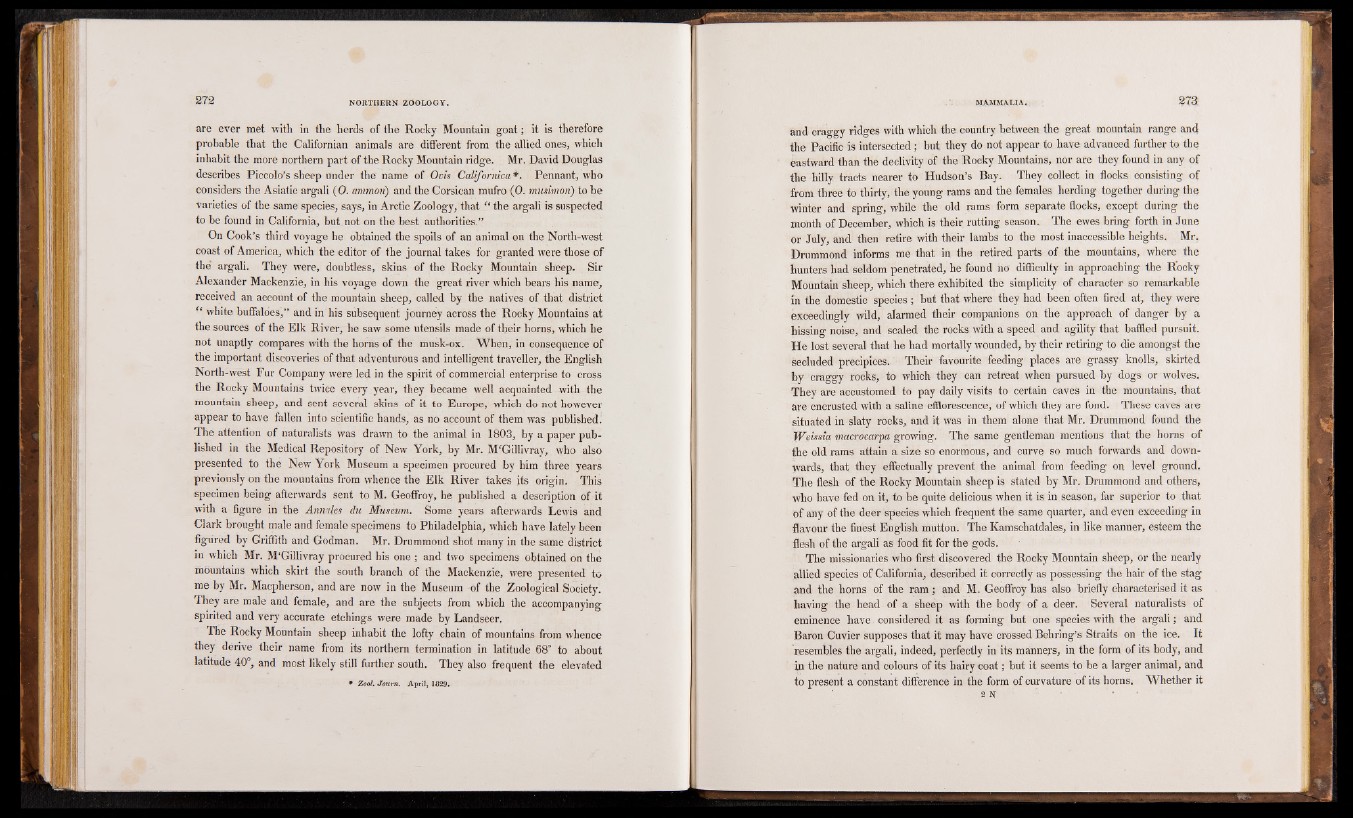
are ever met with in the herds of the Rocky Mountain goat; it is therefore
probable that the Californian animals are different from the allied ones, which
inhabit the more northern part of the Rocky Mountain ridge. Mr. David Douglas
describes Piccolo's sheep under the name of Ovis Calif arnica *. Pennant, who
considers the Asiatic argali (0. ammoti) and the Corsican mufro (0. musimori) to be
varieties of the same species, says, in Arctic Zoology, that “ the argali is suspected
to be found in California, but not on the best authorities.”
On Cook’s third voyage he obtained the spoils of an animal on the North-west
coast of America, which the editor of the journal takes for granted were those of
the argali. They were, doubtless, skins of the Rocky Mountain sheep. Sir
Alexander Mackenzie, in his voyage down the great river which bears his name,
received an account of the mountain sheep, called by the natives of that district
“ white buffaloes,” and in his subsequent journey across the Rocky Mountains at
the sources of the Elk River, he saw some utensils made of their horns, which he
not unaptly compares with the horns of the musk-ox. When, in consequence of
the important discoveries of that adventurous and intelligent traveller, the English
North-west Fur Company were led in the spirit of commercial enterprise to cross
the Rocky Mountains twice every year, they became well acquainted with the
mountain sheep, and sent several skins of it to Europe, which do not however
appear to have fallen into scientific hands, as no account of them was published;
The attention of naturalists was drawn to the animal in 1803, by a paper published
in the Medical Repository of New York, by Mr. M'Gillivray, who also
presented to the New York Museum a specimen procured by him three years
previously on the mountains from whence the Elk River takes its origin. This
specimen being afterwards sent to M. Geoffroy, he published a description of it
with a figure in the Annales du Museum. Some years afterwards Lewis and
Clark brought male and female specimens to Philadelphia, which have lately been
figured by Griffith and Godman. Mr. Drummond shot many in the same district
in which Mr. M’Gillivray procured his one ; and two specimens obtained on the
mountains which skirt the south branch of the Mackenzie, were presented to
me by Mr. Macpherson, and are now in the Museum of the Zoological Society.
They are male and female, and are the subjects from which the accompanying
spirited and very accurate etchings were made by Landseer.
The Rocky Mountain sheep inhabit the lofty chain of mountains from whence
they derive their name from its northern termination in latitude 68“ to about
latitude 40°, and most likely still further south. They also frequent the elevated
* Zool. Joum. April, 1029.
and craggy ridges with which the. country between the. great mountain range and
the Pacific is intersected ; but they do not appear to have advanced further to the
eastward than the declivity of the Rocky Mountains, nor are they found in any of
the hilly tracts nearer to Hudson’s Bay. They collect in flocks, consisting of
from three to thirty, the young rams and the females herding together during the
winter and spring, while the old rams form separate flocks, except during the
month of December, which is their rutting season.. The ewes bring forth in June
or July, and then retire with their lambs to the most inaccessible heights. Mr.
Drummond informs me that in the retired parts of the mountains, where the
hunters had seldom penetrated, he found no difficulty in approaching the Rocky
Mountain sheep, which there exhibited the simplicity of character so remarkable
in the domestic species; but that where they had been often fired at, they were
exceedingly wild, alarmed their companions on the approach of danger by a
hissing noise, and scaled the rocks with a speed and agility that baffled pursuit.
He lost several that he had mortally wounded, by their retiring to die amongst the
secluded precipices.. Their favourite feeding places are grassy knolls, skirted
by craggy rocks, to which they can retreat when pursued by dogs or wolves.
They are accustomed to pay daily visits to certain caves in the mountains, that
are encrusted with a saline efflorescence, of which they are fond. These caves are
situated in slaty rocks, and it was in them alone that Mr. Drummond found the
Weissia macrocarpa growing. The same gentleman mentions that the horns of
the old rams attain a size so enormous, and curve so much forwards and downwards,
that they effectually prevent the animal from feeding on level ground.
The flesh of the Rocky Mountain sheep is stated by Mr. Drummond and others,
who have fed on it, to be quite delicious when it is in season, far superior to that
of any of the deer species which frequent the same quarter, and even exceeding in
flavour the finest English mutton. The Kamschatdales, in like manner, esteem the
flesh of the argali as food fit for the gods.
The missionaries who first discovered the Rocky Mountain sheep, or the nearly
allied species of California, described it correctly as possessing the hair of the stag
and the horns of the ram ; and M. Geoffroy has also briefly characterised it as
having the head of a sheep with the body of a deer. Several naturalists of
eminence have, considered it as forming but one species with the argali; and
Baron Cuvier supposes that it may have crossed Behring’s Straits on the ice. It
resembles the argali, indeed, perfectly in its manners, in the form of its body, and
in the nature and colours of its hairy coat; but it seems to be a larger animal, and
to present a constant difference in the form of curvature of its horns. Whether it
2 N •